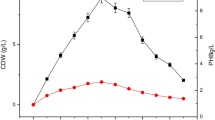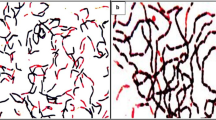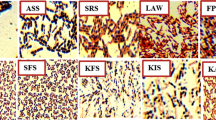Abstract
Many bacteria produce polyhydroxyalkanoates (PHAs) when exposed to stressful conditions. It is a known fact that PHAs have the potential to replace petrochemical-based plastics as they are biodegradable, biocompatible, and thermoprocessible materials. The study focusses on producing PHA from microbes isolated from polluted environments and pomegranate peels were utilized as a unique carbon source. This was done to ensure reduction in the cost of the substrate that has not yet been reported as a substrate for PHA production. A comparative study was also done with Cupriavidus necator, the reference strain. Out of many bacterial strains, isolated, eight of these were found to have ability to produce PHA. Pomegranate peel was substituted as carbon source in the medium and all bacterial isolates along with reference strain were used to test their ability to produce PHA from waste. Cupriavidus necator, the reference strain, yielded 71% PHA. Bacillus halotolerans DSM8802 yielded 83% at 1:1:: C:N ratio at 72 h.





Similar content being viewed by others
References
Aburas MMA (2016) Production of poly β-hydroxybutyrate from Pseudomonas putida MAO12 isolated from waste water sample. J Am Sci 12(5):107–112
Azeredo CMH, Miranda EWK, Ribeiro LH, Rosa FM (2012) Nanoreinforced alginate-acerola puree coatings on acerola fruits. J Food Eng 113:505–510
Chaitanya K, Mahmood SK, Rana K, Sunil KN (2014) Biotechnological production of polyhydroxyalkanoates by various isolates: a review. Int J Pharm Sci Invent 3(9):01–11
Chanprateep S (2010) Current trends in biodegradable polyhydroxyalkanoates. J Biosci Bioeng 110(6):621–632
Chee JY, Yoga SS, Lau NS, Ling SC, Abed RMM, Sudesh K (2010) Bacterially produced polyhydroxyalkanoates (PHAs): converting renewable resources into bioplastics. In: Mendez- Vilas A (ed) Applied microbiology and microbial biotechnology. Universiti Sains Penang, Malaysia, Formatex, pp 395–1404
Du G, Chen J, Yu J, Lun S (2001) Continuous production of poly-3-hydroxybutyrate by Ralstonia eutropha in a two-staged culture system. J Biotechnol 88:59–65
Dubois M, Gilles KA, Hamilton JK, Rebers PA, Smith F (1956) Colorimetric method for determination of sugars and related substances. Anal Chem 28(3):350–356
Farris S, Schaich MK, Liu L, Piergiovanni L, Yam LK (2009) Development of polyion-complex hydrogels as an alternative approach for the production of bio-based polymers for food packaging applications: a review. Trends Food Sci Technol 20:316–332
Fernandez-Castillo R, Rodriguez-Valera F, Gonalez-Ramos J, Ruiz-Berraquero F (1986) Accumulation of poly (β- hydroxybutyrate) by Halobacteria. Appl Env Microbiol 51(1):214–216
Gabor D, Tita O (2012) Biopolymers used in food packaging: a review. Acta Universitatis Cibiniensis Series E Food Technol 16(2):3–19
Girija D, Deepa K, Xavier F, Antony I, Shidhi PR (2013) Analysis of cow dung microbiota—a metagenomic approach. Ind J Biotechnol 12:372–378
Godoy F, Vancanneyt M, Martinez M, Steinbüchel A, Swings J, Rehm BH (2003) Sphingopyxis chilensis sp. nov, a chlorophenol-degrading bacterium that accumulates polyhydroxyalkanoates and transfer of Sphingomonas alaskensis to Sphingopyxis alaskensis comb. nov. Int J Syst Evol Microbiol 53:473–477
Gomaa EZ (2014) Production of polyhydroxyalkanoates (PHAs) by Bacillus subtilis and Escherichia coli Grown on Cane Molasses Fortified with ethanol. Braz Arch Biol Tech 51(1):145–154
Gowda V, Shivakumar S (2014) Agrowaste-based polyhydroxyalkanoate (PHA) production using hydrolytic potential of Bacillus thuringiensis IAM12077. Braz Arch Biol Technol 57(1):55–61
Hawas JME-M, El-Banna TE-S, Belal EBA, El-Aziz AAA (2016) Production of bioplastics from some selected bacterial strains. Int J Curr Microbiol App Sci 5(1):10–22
Heinrich D, Madkour MH, Al-Ghamdi MA, Shabbaj II (2012) Large scale extraction of poly (3-hydroxybutyrate) from Ralstonia eutropha H16 using sodium hypochlorite. AMB Express 2(59):1–6
Jacquel N, Lo CW, Wei YH, Wu HS, Wang SS (2008) Isolation and purification of bacterial poly (3-hydroxyalkanoates). Biochem Eng J 39:15–27
Krishnaveni S, Balasubramanian T, Sadasivam S (1984) Sugar distribution in sweet stalk sorghum. Food Chem 15:229–232
Kumar PKA, Shamala TR, Kshama L, Prakash MH, Joshi GJ, Chandrashekar A, Kumari KSL, Divyashree MS (2007) Bacterial synthesis of poly (hydroxybutyrate-co- hydroxyvalerate) using carbohydrate- rich Mahua (Madhuca.sps) flowers. J Appl Microbiol 103:204–209
Kumar T, Singh M, Purohit HJ, Kalia VC (2009) Potential of Bacillus sp. to produce polyhydroxybutyrate from biowastes. J Appl Microbiol 106:2017–2023
Kumari P, Dhingra KH (2013) Isolation and characterization of PHB producing micro-organisms isolated from root nodules of leguminous plants. Int Q J L Sci 8(1):109–113
Marjadi D, Dharaiya N (2011) Isolation, screening and characterization of polyhydroxyalkanoates producing bacteria utilizing edible oil as carbon sources. J Env Res Dev 5(3):764–772
Omar FN, Rahman NAA, Hafid HS, Mumtaz T, Yee PL, Hassan MA (2011) Utilization of kitchen waste for the production of green thermoplastic polyhydroxybutyrate (PHB) by Cupriavidus necator CCGUG 52238. Afr J Microbiol Res 5(19):2873–2879
Paul S, Sasikumar SC, Balakumaran MD (2017) Optimization, purification and characterization of polyhydroxybutyrate (PHB) produced by Bacillus cereus Isolated from sewage. Int J Chemtech Res 10(7):884–904
Porwal S, Kumar T, Lal S, Rani A, Kumar S, Cheema S, Purohit JH, Sharma R, Patel SKS, Kalia CV (2008) Hydrogen and Polyhydroxybutyrate producing abilities of microbes from diverse habitats by dark fermentative process. Bioresour Technol 99:5444–5451
Prabhu NN, Santimano MC, Mavinkurve S, Bhosle SN, Garg S (2010) Native granule associated short chain length polyhydroxyalkanoate synthase from marine derived Bacillus sp. NQ-11/A2. Antonie Van Leeuwenhoek 97:41–50
Preethi R, Sasikala P, Aravind J (2012) Microbial production and polyhydroxyalkanoate (PHA) utilizing fruit waste as a substrate. Res Biotechnol 3(1):61–69
Rayasam V, Kumar T (2018) Banana peel as an inexpensive carbon source for microbial polyhydroxyalkanoates (PHA) production. Int Res J Env Sci 7(1):1–8
Rayasam V, Kumar T (2019) Microbial production of polyhydroxyalkanoates (PHAs) using kitchen waste as an inexpensive carbon source. Biosci Biotechnol Res Asia 16(1):155–166
Raza ZA, Abid S, Banat MI (2018) Polyhydroxyalkanoates: characteristics, production, recent developments and applications. Int Biodeterior Biodegrad 126:45–56
Ruban WS (2009) Biobased packaging-application in meat industry. Vet World 2(2):79–82
Santhanam A, Sasidharan S (2010) Microbial production of polyhydroxyalkanoates (PHA) from Alcaligens spp. and Pseudomonas oleovorans using different carbon sources. Afr J Biotechnol 9(21):3144–3150
Shah RK (2014) Optimization and production of polyhydroxybutyrate (PHB) by Bacillus subtilis G1S1 from soil. Int J Curr Microbiol Appl Sci 3(5):377–387
Shivakumar S (2012) Accumulation of poly (3-hydroxybutyrate) by Microbacterium barkeri DSM 20145. Turk J Biol 36:225–232
Song HJ, Jeon OC, Choi HM, Yoon CS, Park W (2008) Polyhydroxyalkanoates (PHA) production using waste vegetable oil by Pseudomonas sp. Strain DR2. J Microbiol Biotechnol 18(8):1408–1415
Souza SWB, Cerqueira AM, Martins TJ, Casariego A, Teixeira AJ, Vicente AA (2010) Influence of electric fields on the structure of chitosan edible coatings. Food Hydrocoll 24:30–335
Srilakshmi S, Ramachandra Rao VSC (2012) Studies on screening, isolation and molecular characterization of PHB producing Staphylococcus spp. Int J Int Sci Inn Tech Sec B 1(5):24–31
Tembadmani K, Shankar A, D’Souza S, Narvekar M, Rao P (2015) Microbial production of polyhydroxyalkanoates (PHA) from novel sources: a review. Int J Res Biosci 4(4):16–28
Thapa C, Shakya P, Shrestha R, Pal S, Manandhar P (2018) Isolation of polyhydroxybutyrate (PHB) producing bacteria, optimization of culture conditions of PHB Production, Extraction and characterization of PHB. Nepal J Biotechnol 6(1):62–68
Yao J, Zhang G, Wu Q, Chen GQ, Zhang R (1999) Production of polyhydroxyalkanoates by Pseudomonas nitroreducens. Antonie Van Leeuwenhoek 75:345–349
Zaid M, Jamil N (2015) Production and in-vitro evaluation of bioplastics produced by bacteria using Bagasse. In: International conference on chemical, food and environmental engineering (ICCFEE), Dubai (UAE). https://doi.org/10.17758/IAAST.A0115051:11-12
Zhu C, Liu X (2013) Optimization of extraction process of crude polysaccharides from pomegranate peel by response surface methodology. Carbohydr Polym 92:1197–1202
Acknowledgements
We are thankful to Dr. P. Shyama Raju, The Founder and Hon’ble Chancellor of Reva University; Dr. N. Ramesh, the Dean- Training, Placement and Planning and Dr. M. Dhanamjaya, the Registrar of Reva University, Bangalore for constant support and encouragement. We are grateful to Sateesh. G. Muttagi, CEO; Dr. Siddalingeshwar. K. G, Quality Manager and Mr. Babu. S, Business Development Head of Scientific and Industrial Research Center (NABL) Laboratories, Bangalore for providing the lab facilities and for their constant support and assistance. We are grateful to Prof. K.D. Vachhrajani, Head of the Department, Department of Environmental Studies and Prof. H.R. Kataria, Dean, Faculty of Science, The Maharaja Sayajirao University of Baroda for encouragement. We express our immense gratitude towards the GSBTM (Gujarat State Biotechnology Mission) for providing the funding through BIOTHON grant.
Funding
GSBTM, Government of Gujarat, Department of Science and Technology, India.
Author information
Authors and Affiliations
Corresponding author
Ethics declarations
Conflict of interest
No conflict of interest.
Additional information
Communicated by Erko Stackebrandt.
Publisher's Note
Springer Nature remains neutral with regard to jurisdictional claims in published maps and institutional affiliations.
Electronic supplementary material
Below is the link to the electronic supplementary material.
Rights and permissions
About this article
Cite this article
Rayasam, V., Chavan, P. & Kumar, T. Polyhydroxyalkanoate synthesis by bacteria isolated from landfill and ETP with pomegranate peels as carbon source. Arch Microbiol 202, 2799–2808 (2020). https://doi.org/10.1007/s00203-020-01995-9
Received:
Revised:
Accepted:
Published:
Issue Date:
DOI: https://doi.org/10.1007/s00203-020-01995-9




